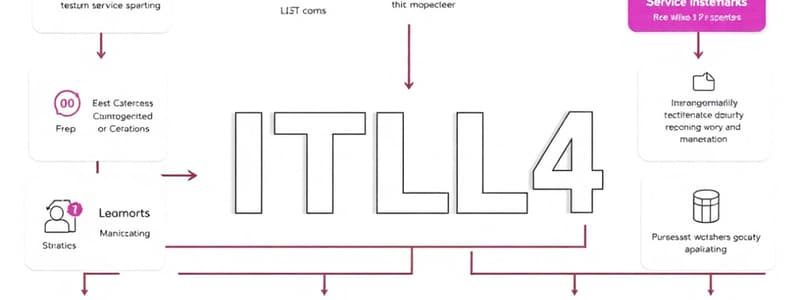Podcast
Questions and Answers
What is the purpose of Architecture Management in ITIL?
What is the purpose of Architecture Management in ITIL?
Which of the following is NOT a step in the ITIL Continual Improvement Model?
Which of the following is NOT a step in the ITIL Continual Improvement Model?
How are the 34 management practices of ITIL grouped?
How are the 34 management practices of ITIL grouped?
Which management practice is foundational for the governance and management of modern organizations?
Which management practice is foundational for the governance and management of modern organizations?
Signup and view all the answers
What type of demands does the ITIL service value system manage?
What type of demands does the ITIL service value system manage?
Signup and view all the answers
What is the first step in the Continual Improvement Model?
What is the first step in the Continual Improvement Model?
Signup and view all the answers
Which statement best describes the role of Continual Improvement in ITIL?
Which statement best describes the role of Continual Improvement in ITIL?
Signup and view all the answers
Which of the following activities is part of Architecture Management?
Which of the following activities is part of Architecture Management?
Signup and view all the answers
What is the primary goal of portfolio management?
What is the primary goal of portfolio management?
Signup and view all the answers
Which of the following is NOT a key activity in project management?
Which of the following is NOT a key activity in project management?
Signup and view all the answers
Which activity is essential for effective relationship management?
Which activity is essential for effective relationship management?
Signup and view all the answers
What does risk management primarily focus on?
What does risk management primarily focus on?
Signup and view all the answers
In service financial management, what is a key purpose?
In service financial management, what is a key purpose?
Signup and view all the answers
Which of the following activities would help in monitoring portfolio performance?
Which of the following activities would help in monitoring portfolio performance?
Signup and view all the answers
What is an essential part of developing a project plan?
What is an essential part of developing a project plan?
Signup and view all the answers
Which activity is NOT typically associated with relationship management?
Which activity is NOT typically associated with relationship management?
Signup and view all the answers
What is the relationship between portfolio management and resource allocation?
What is the relationship between portfolio management and resource allocation?
Signup and view all the answers
Which of the following best describes a primary purpose of risk management?
Which of the following best describes a primary purpose of risk management?
Signup and view all the answers
What is the primary purpose of capacity and performance management?
What is the primary purpose of capacity and performance management?
Signup and view all the answers
Which activity is part of the change enablement process?
Which activity is part of the change enablement process?
Signup and view all the answers
Incident management primarily aims to address what aspect of services?
Incident management primarily aims to address what aspect of services?
Signup and view all the answers
In the context of IT asset management, which of the following encompasses its definition?
In the context of IT asset management, which of the following encompasses its definition?
Signup and view all the answers
Which of the following is NOT a key activity in the requirements management process?
Which of the following is NOT a key activity in the requirements management process?
Signup and view all the answers
What is the main focus of incident management?
What is the main focus of incident management?
Signup and view all the answers
Which activity is crucial in capacity and performance management?
Which activity is crucial in capacity and performance management?
Signup and view all the answers
How does change enablement assess risks?
How does change enablement assess risks?
Signup and view all the answers
What is considered a key aspect of IT asset management?
What is considered a key aspect of IT asset management?
Signup and view all the answers
Which of the following best describes the validation of requirements?
Which of the following best describes the validation of requirements?
Signup and view all the answers
What is the primary objective of service validation and testing?
What is the primary objective of service validation and testing?
Signup and view all the answers
Which of the following activities is NOT part of deployment management?
Which of the following activities is NOT part of deployment management?
Signup and view all the answers
What activity is emphasized in infrastructure and platform management to ensure the system is secure?
What activity is emphasized in infrastructure and platform management to ensure the system is secure?
Signup and view all the answers
What modern approaches are recognized as important in the software development and management practice?
What modern approaches are recognized as important in the software development and management practice?
Signup and view all the answers
How do the ITIL management practices function concerning the organization's strategic goals?
How do the ITIL management practices function concerning the organization's strategic goals?
Signup and view all the answers
Which activity is NOT a key function of service continuity management?
Which activity is NOT a key function of service continuity management?
Signup and view all the answers
What is the main objective of service design?
What is the main objective of service design?
Signup and view all the answers
Which key activity is part of service level management?
Which key activity is part of service level management?
Signup and view all the answers
What is the primary purpose of a service desk?
What is the primary purpose of a service desk?
Signup and view all the answers
Which of the following is a key activity of service request management?
Which of the following is a key activity of service request management?
Signup and view all the answers
In service continuity management, which of the following actions is crucial for responding to disruptions?
In service continuity management, which of the following actions is crucial for responding to disruptions?
Signup and view all the answers
Which of these activities is part of service design rather than service continuity management?
Which of these activities is part of service design rather than service continuity management?
Signup and view all the answers
What is the goal of monitoring service performance in the context of a service desk?
What is the goal of monitoring service performance in the context of a service desk?
Signup and view all the answers
Which of the following best describes the purpose of capacity management?
Which of the following best describes the purpose of capacity management?
Signup and view all the answers
Which document is essential in service level management to specify expected service performance?
Which document is essential in service level management to specify expected service performance?
Signup and view all the answers
Study Notes
ITIL Service Management Practices
- ITIL 4 defines a management practice as a set of organizational resources designed to perform work or accomplish an objective.
- These practices are grouped into four dimensions of service management and are key elements of the ITIL service value system (SVS).
- The SVS allows organizations to manage demands ranging from strategic demands to operational requests.
- ITIL 4 identifies 34 management practices categorized as:
- General management practices
- Service management practices
- Technical management practices
General Management Practices
- These practices adapted from general business management are foundational to the governance and management of any modern organization.
- Architecture Management provides a holistic view of the organization's strategy, operating model, and service portfolio.
- Continual Improvement ensures that an organization's performance continually meets stakeholder's expectations.
- Portfolio Management helps organizations make decisions about which services to offer, how to invest in them, and how to manage them throughout their lifecycles.
- Project Management delivers projects on time, within budget, and to the required standard.
- Relationship Management builds and maintains positive relationships with stakeholders.
- Risk Management identifies, assesses, and controls risks.
- Service Financial Management ensures that the organization's financial resources are used effectively and efficiently to deliver value through services.
- Capacity and Performance Management ensures that services achieve agreed and expected performance while satisfying current and future demand cost-effectively.
- Change Enablement maximizes successful service and product changes by ensuring that risks are properly assessed.
- Incident Management minimizes the negative impact of incidents by restoring normal service operation as quickly as possible.
-
IT Asset Management plans and manages the full lifecycle of IT assets to maximize value, control costs, manage risks, and meet regulatory and contractual requirements.
- IT assets typically include hardware, software, networks, cloud services, and client devices.
- Service Continuity Management establishes and maintains a plan to enable business and IT services to continue at defined acceptable levels in the event of disruptive incidents.
- Service Design ensures that new or changed services meet the needs of customers and users.
- Service Desk provides a single point of contact for customers and users to report incidents, request services, and receive assistance.
- Service Level Management ensures that services meet agreed-upon service levels.
- Service Request Management supports the agreed and authorized fulfillment of service requests.
- Service Validation and Testing confirms that services meet the agreed requirements before they go live.
Technical Management Practices
- These practices are adapted from technology management domains for service management.
- Deployment Management moves new or changed hardware, software, documentation, processes, or other components to live environments.
- Infrastructure and Platform Management manages the organization's IT infrastructure and platforms, ensuring they are available, reliable, and secure.
- Software Development and Management builds and maintains software applications that meet the needs of the organization and its customers.
Putting it All Together
- The ITIL management practices work together to support the ITIL SVS, enabling the organization to create value through services.
- Each practice makes a unique contribution to service management, and they are all interconnected.
- To be effective, the practices must be aligned with the organization's overall strategy and goals.
Studying That Suits You
Use AI to generate personalized quizzes and flashcards to suit your learning preferences.
Related Documents
Description
Test your knowledge on ITIL 4's management practices and their roles within service management. This quiz covers the four dimensions of service management and the 34 identified practices. Familiarize yourself with general, service, and technical management practices essential for modern organizations.



